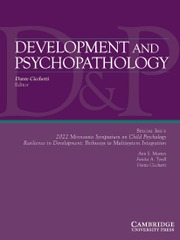Crossref Citations
This article has been cited by the following publications. This list is generated based on data provided by
Crossref.
Franke, Barbara
2016.
Heritability of a General Psychopathology Factor in the Population: Potential Implications for Classification and Treatment.
Journal of the American Academy of Child & Adolescent Psychiatry,
Vol. 55,
Issue. 12,
p.
1016.
Malhi, Gin S.
Byrow, Yulisha
Outhred, Tim
Das, Pritha
and
Fritz, Kristina
2017.
Irritability and internalizing symptoms: Modeling the mediating role of emotion regulation.
Journal of Affective Disorders,
Vol. 211,
Issue. ,
p.
144.
Hannigan, Laurie J.
Pingault, Jean-Baptiste
Krapohl, Eva
McAdams, Tom A.
Rijsdijk, Frühling V.
and
Eley, Thalia C.
2018.
Genetics of co-developing conduct and emotional problems during childhood and adolescence.
Nature Human Behaviour,
Vol. 2,
Issue. 7,
p.
514.
Kjellstrand, Jean
Yu, Gary
Eddy, J. Mark
and
Martinez, Charles R.
2018.
Children of Incarcerated Parents: Developmental Trajectories of Externalizing Behavior Across Adolescence.
Criminal Justice and Behavior,
Vol. 45,
Issue. 11,
p.
1742.
Flouri, Eirini
Papachristou, Efstathios
Midouhas, Emily
Joshi, Heather
Ploubidis, George B.
and
Lewis, Glyn
2018.
Early adolescent outcomes of joint developmental trajectories of problem behavior and IQ in childhood.
European Child & Adolescent Psychiatry,
Vol. 27,
Issue. 12,
p.
1595.
Bartels, Meike
Hendriks, Anne
Mauri, Matteo
Krapohl, Eva
Whipp, Alyce
Bolhuis, Koen
Conde, Lucia Colodro
Luningham, Justin
Fung Ip, Hill
Hagenbeek, Fiona
Roetman, Peter
Gatej, Raluca
Lamers, Audri
Nivard, Michel
van Dongen, Jenny
Lu, Yi
Middeldorp, Christel
van Beijsterveldt, Toos
Vermeiren, Robert
Hankemeijer, Thomas
Kluft, Cees
Medland, Sarah
Lundström, Sebastian
Rose, Richard
Pulkkinen, Lea
Vuoksimaa, Eero
Korhonen, Tellervo
Martin, Nicholas G.
Lubke, Gitta
Finkenauer, Catrin
Fanos, Vassilios
Tiemeier, Henning
Lichtenstein, Paul
Plomin, Robert
Kaprio, Jaakko
and
Boomsma, Dorret I.
2018.
Childhood aggression and the co-occurrence of behavioural and emotional problems: results across ages 3–16 years from multiple raters in six cohorts in the EU-ACTION project.
European Child & Adolescent Psychiatry,
Vol. 27,
Issue. 9,
p.
1105.
Wang, Yiji
and
Yan, Ni
2019.
Trajectories of internalizing and externalizing problems in preschoolers of depressed mothers: Examining gender differences.
Journal of Affective Disorders,
Vol. 257,
Issue. ,
p.
551.
Little, Stephanie A.
Germeroth, Carrie
and
Garber, Judy
2019.
Father–Adolescent Conflict and Adolescent Symptoms: The Moderating Roles of Father Residential Status and Type.
Journal of Child and Family Studies,
Vol. 28,
Issue. 11,
p.
3193.
Havewala, Mazneen
Felton, Julia W.
and
Lejuez, Carl W.
2019.
Friendship Quality Moderates the Relation between Maternal Anxiety and Trajectories of Adolescent Internalizing Symptoms.
Journal of Psychopathology and Behavioral Assessment,
Vol. 41,
Issue. 3,
p.
495.
Kjellstrand, Jean
Yu, Gary
and
Eddy, J. Mark
2019.
Parental incarceration as a predictor of developmental trajectories of externalizing behaviors across adolescence.
Children and Youth Services Review,
Vol. 103,
Issue. ,
p.
10.
Kjellstrand, Jean
Yu, Gary
Eddy, J. Mark
and
Clark, Miriam
2020.
Children with Incarcerated Parents and Developmental Trajectories of Internalizing Problems across Adolescence.
American Journal of Criminal Justice,
Vol. 45,
Issue. 1,
p.
48.
Winsper, Catherine
Bilgin, Ayten
and
Wolke, Dieter
2020.
Associations between infant and toddler regulatory problems, childhood co‐developing internalising and externalising trajectories, and adolescent depression, psychotic and borderline personality disorder symptoms.
Journal of Child Psychology and Psychiatry,
Vol. 61,
Issue. 2,
p.
182.
Papachristou, Efstathios
and
Flouri, Eirini
2020.
Distinct developmental trajectories of internalising and externalising symptoms in childhood: Links with mental health and risky behaviours in early adolescence.
Journal of Affective Disorders,
Vol. 276,
Issue. ,
p.
1052.
Oerlemans, Anoek M.
Wardenaar, Klaas J.
Raven, Dennis
Hartman, Catharina A.
Ormel, Johan
and
Santana, Geilson Lima
2020.
The association of developmental trajectories of adolescent mental health with early-adult functioning.
PLOS ONE,
Vol. 15,
Issue. 6,
p.
e0233648.
Vine, Vera
Byrd, Amy L.
Mohr, Harmony
Scott, Lori N.
Beeney, Joseph E.
and
Stepp, Stephanie D.
2020.
The Structure of Psychopathology in a Sample of Clinically Referred, Emotionally Dysregulated Early Adolescents.
Journal of Abnormal Child Psychology,
Vol. 48,
Issue. 11,
p.
1379.
Kjellstrand, Jean
Yu, Gary
Eddy, J. Mark
Clark, Miriam
and
Jackson, Arriell
2020.
The role of parental incarceration in predicting trajectories of child internalizing problems.
Children and Youth Services Review,
Vol. 115,
Issue. ,
p.
105055.
Gutman, Leslie Morrison
and
Codiroli McMaster, Natasha
2020.
Gendered Pathways of Internalizing Problems from Early Childhood to Adolescence and Associated Adolescent Outcomes.
Journal of Abnormal Child Psychology,
Vol. 48,
Issue. 5,
p.
703.
de la Torre-Luque, Alejandro
Fiol-Veny, Aina
Balle, Maria
Nelemans, Stefanie A.
and
Bornas, Xavier
2020.
Anxiety in Early Adolescence: Heterogeneous Developmental Trajectories, Associations with Risk Factors and Depressive Symptoms.
Child Psychiatry & Human Development,
Vol. 51,
Issue. 4,
p.
527.
Tien, Joyce
Lewis, Gary D.
and
Liu, Jianghong
2020.
Prenatal risk factors for internalizing and externalizing problems in childhood.
World Journal of Pediatrics,
Vol. 16,
Issue. 4,
p.
341.
Olivier, Elizabeth
Morin, Alexandre J. S.
Langlois, Jessika
Tardif-Grenier, Kristel
and
Archambault, Isabelle
2020.
Internalizing and Externalizing Behavior Problems and Student Engagement in Elementary and Secondary School Students.
Journal of Youth and Adolescence,
Vol. 49,
Issue. 11,
p.
2327.

